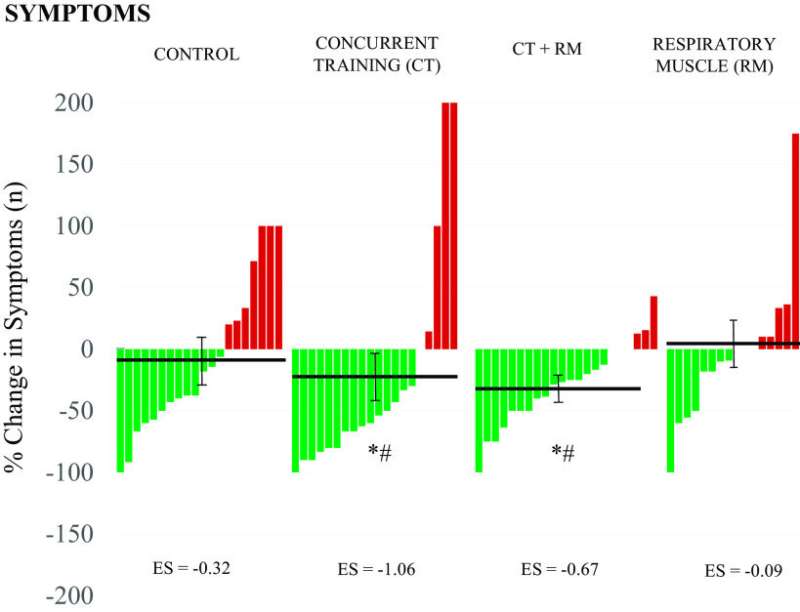Changes in total number of symptoms after 8 wk of follow-up. Data expressed with means ± SEM and effect size (ES). *Statistically significant differences from CON group, #statistically significant differences from RM group. CON, control. Credit: Journal of Applied Physiology (2022). DOI: 10.1152/japplphysiol.00489.2022
A research team from the University of Murcia, Spain, found a supervised, eight-week exercise program improved symptoms of patients with long COVID better than the current standard self-managed rehabilitation recommendations. The study is published ahead of print in the Journal of Applied Physiology.
Commonly referred to as "long COVID" or "long-haul COVID," post-COVID-19 condition occurs when symptoms develop or persist three months after SARS-CoV-2 infection. Common long COVID symptoms include brain fog, fatigue, shortness of breath and decline of mental health. Though estimated rates of people who develop long COVID vary, even the lower end of the range counts in the millions.
In an outpatient setting, long COVID interventions are currently limited to self-guided advice, such as the World Health Organization's (WHO) "Support for Rehabilitation: Self-Management after COVID-19-Related Illness" brochure. In this study, researchers compared a supervised concurrent exercise approach to the self-guided brochure. Concurrent exercise was a combination of aerobic and strength training.
Groups of about 20 people each participated in one of four intervention types: supervised concurrent exercise, specialty breathing exercises, a combination of concurrent exercise and breathing exercises, or self-guided efforts following the WHO brochure. The concurrent training involved two sessions a week of strength training and light to moderate variable intensity aerobic exercise and one session of light intensity continuous aerobic exercise.
All sessions were conducted under medical supervision and directed by certified exercise coaches. To be included in the study, the volunteers needed to participate in at least 20 of the 24 sessions.
Over 80% of the concurrent exercise participants responded well to the intervention. Both groups that included the concurrent training showed greater reductions in long COVID symptoms compared to the other groups. In addition, their fatigue and depression levels improved, and lower and upper body strength increased.
The research team emphasized that unlike other studies conducted in specialized rehabilitation centers, this intervention is accessible "with a low investment of resources, safely in any training center and supervised by qualified strength and conditioning coaches."
More information: Amaya Jimeno-Almazán et al, Effects of a concurrent training, respiratory muscle exercise, and self-management recommendations on recovery from post-COVID-19 conditions: the RECOVE trial, Journal of Applied Physiology (2022). DOI: 10.1152/japplphysiol.00489.2022
Journal information: Journal of Applied Physiology
Provided by American Physiological Society
























